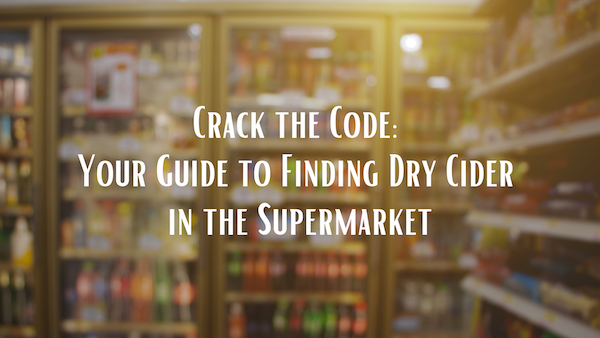Crack the Code: Your Guide to Finding Dry Cider in the Supermarket

Ready to get in on the fun this Dry Cider July? Let’s talk about the best ways to find dry cider at the supermarket. With a plethora of options from fruity summer flavors, botanical ciders, and distractingly beautiful labels, it can be hard to determine which ones are dry. Thankfully, there are some telltale signs whether the cider that’s caught your eye is dry or not.
First, let’s talk about the difference between dry vs. sweet cider labels. Ciders in the U.S. are labelled based on their residual sugar, and fit into one of four categories: Sweet, Semi-Sweet, Semi-Dry, or Dry. This month celebrates the driest of the dry. Dry ciders have 0 grams of sugar and what we’ll be focusing on. We’ll also touch on semi-dry ciders if that’s more your speed. It still counts on the ‘gram. So, how to choose? Here are four strategies to determine whether or not a cider is dry.
Cider Name or Subtext
On the face of the cider, the can or bottle should have a name. If the name or subtext includes dry, semi-dry, off-dry or brut, we’re on the dry end of the spectrum. Conversely, if we find sweet or semi-sweet listed, we can eliminate those options.
Brut aside: Brut is a style of cider modeled after the French Brut Champagne. Cideries take different approaches to honor this beverage’s French origin by means of aging the cider on French wine barrels or using champagne yeast. What all Brut ciders have in common is their sparkling nature and zero grams of residual cider.
Cider Descriptors
Another way to tell if the cider in your hand is dry is to spin the can around and look for descriptors provided by the cidery. Many cideries provide a brief description of the cider, highlighting tasting notes and how to best experience it either temperature-wise or with food pairings. Some cideries go above and beyond by providing a sweet-to-dry sliding scale, denoting where this particular cider falls.
Sugar Content
If the other two methods haven’t brought you an answer yet, another option is to check the nutritional facts. This method can be unreliable as nutritional facts are not universally required for cider. However, if the nutrition facts are available, check how many grams of sugar are in the can. Generally, if there are 0-3 grams of sugar in a 16 oz can, you are squarely in dry country. If you’re more in a semi-dry mood, look for 4-10 grams of sugar.
Earlier this month in the ACA blog, Tim Godfrey highlighted that a dry cider might not taste dry after all. My favorite examples of this phenomenon are fruit ciders and ciders featuring the McIntosh apple. Fruit ciders bring their own character to the table and the fruitiness can trick our brain into thinking a cider with 0 grams of sugar is a sweet cider. Similarly, McIntosh apples are flamboyant, botanical apples that bring what our brains interpret as sweetness to the drink. These ciders can provide a different kind of dry cider experience.
Zero (or no) Sulfites
This final strategy to determine if you have a dry cider is a tried but not always true method. Look to see if the can lists zero (or no) sulfites. The addition of sulfites is a common method to stop the cider’s fermentation process before the cider is fully dry. If the cider lists that it is sulfite-free, you most likely have yourself a dry cider. Many cideries let their cider go completely dry to negate the need for sulfites. Because sulfites are a method of halting fermentation before a cider is fully dry, their presence likely indicates a sweeter cider. Note that some cideries may choose to add sulfites to their dry cider as a precautionary measure.
Whichever method you choose to follow here, listen to your gut. What sounds good to you? What flavor profile will appeal to your friends at the bottle share? And, if you follow these tips to your next favorite dry cider, let us know on Instagram using #dryciderjuly and #pickdrycider. Cheers!
Want a cheat sheet for dry cider near you? Check out our Dry Cider Finder!

Alexsis Cassady is a cider influencer and Certified Pommelier™ who can be found on Instagram @ciderminded.

[…] who can be found on Instagram @ciderminded. This article was originally published on the American Cider Association blog and is shared here with […]